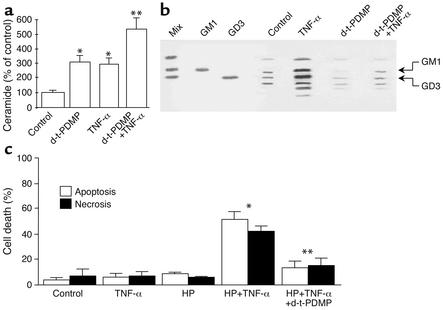Figure 6.
Effect of glucosylceramide synthetase inhibition on sphingolipids and hepatocellular survival. (a) Cultured hepatocytes were treated with TNF-α (280 ng/ml) for 2 hours with or without d-threo-PDMP (d-t-PDMP) pretreatment to inhibit glucosylceramide synthase. Cellular lipids were extracted by chloroform/methanol, and ceramide levels were determined by high-performance liquid chromatography. Results are expressed as means ± SD (n = 4 independent experiments). *P < 0.05 versus control, and **P < 0.05 versus HP plus TNF-α. (b) Lipid extracts from hepatocytes treated with TNF-α with or without d-threo-PDMP were applied to high-performance thin-layer chromatography plates to resolve glycosphingolipids along with authentic ganglioside standards (GD3 and GM1). The level of GD3 was calculated by densitometric analyses of high-performance thin-layer chromatography plates and compared with a standard curve generated using known amounts of GD3. (c) To determine the role of glycosphingolipid synthesis inhibition on hepatocellular survival, cells were first treated with HP and then exposed to TNF-α for 12 hours with or without d-threo-PDMP pretreatment. Cell death was determined by Hoechst 33258 and propidium iodide staining after 12 hours of TNF-α incubation. Results are expressed as means ± SD (n = 6 independent experiments). *P < 0.05 versus control, and **P < 0.05 versus HP plus TNF-α.

